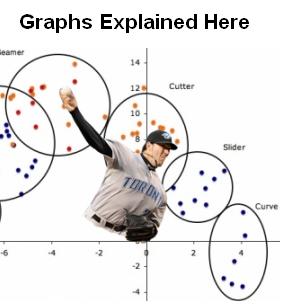More on the Wind vs. Dickey’s Knuckleball
One more thing to add about the effect of a closed dome — there is another variable used to describe movement in pitch f/x, called “break length”, which is defined as:
“…the greatest distance between the trajectory of the pitch at any point between the release point and the front of home plate, and the straight line path from the release point and the front of home plate.”
Here is a graphic ripped off from a John Walsh article showing what that means:

Basically, if you threw a curveball that instead of travelling in a perfectly straight line from your hand to the catcher’s glove, went ten feet up and then back down into the mitt, the break length of that pitch would be 10 feet. It doesn’t matter if it breaks down or sideways, just how “loopy”, or “bendy” the breaking pitch is. I rarely end up using this number, because I’m never sure if that’s a good thing or not. In the case of sliders, it’s a bad thing: you want a tight slider that looks like a fastball until the last minute. In the case of most curves, it’s a good thing: the more knee-buckling, the better.
You have to just ignore the early spikes on these graphs because it’s based on a super-small sample size of a single game at 1 and 3 mph, but if we compare wind magnitude (mph) to break length (inches), there is a clear and sustained connection between the ‘loopiness’ of Dickey’s knuckler and how hard the wind is blowing:
That’s what you might expect from a pitch that is dependent on interacting with air currents for its movement, but for some reason it also leads to batters taking more cuts:
And especially in very windy conditions, getting way more hits:
Again, each knuckleball is so random it’s mostly speculation exactly what is making them more appealing to swing at and easier to get a hit off, but this is another indication that a closed dome really helps R.A. — if only to escape the nightmare of a stiff breeze. Perhaps, as has driven the modern trend away from big breaking balls to splitters and cutters (and Dickey’s Cy Young season being due to a harder knuckler with less movement on it) pitches that break a lot are impressive, but not as effective against major-leaguers as those that seem to be hittable and then dart away at the last moment.





Great stuff, I hope Dickey reads it. And I also hope I can figure out why my comments to your last bunch of articles gave me a “WordPress cannot post” message.
patches42
October 17, 2013 at 6:11 pm
Very interesting; nice charts.
Lobinatorexpress
October 17, 2013 at 8:19 pm
[…] And there’s a second post at the Mockingbird, which looks specifically at the impact of wind on the knuckleball– as he did in the previous piece as well. As always, outstanding stuff. […]
The Daily Duce: Tuesday, October 15th | Drunk Jays Fans | Blogs | theScore.com
December 29, 2013 at 2:44 pm